 The Imperial Trans-Antarctic Expedition (1914-1917)
The Imperial Trans-Antarctic Expedition (1914-1917)
Shackleton’s Imperial Trans-Antarctic Expedition was the last great undertaking of the heroic age of Antarctic exploration. He embarked in 1914 on the Endurance to make the first traverse of the Antarctic continent: a journey of some 1,800 miles from sea to sea. In 1915 the Endurance was sunk by pack ice, leaving Shackleton and his 27 crew members in smaller boats that were ill equipped for the rough Weddell Sea. They sailed to Elephant Island, where they made an encampment from two upturned boats. Shortly thereafter, Shackleton, Worsley, and Tom Crean made a gruelling trip for help, which they found at a whaling station on the north side of South Georgia. Subsequently, four separate attempts were made to rescue the remaining crew members on the desolate Elephant Island. By the time they were rescued, the men had survived for five and a half months on a diet of seals and penguins. Shackleton’s expedition succeeded in creating a polar epic of bravery and leadership. An astonishing scientific discovery was made on 5 March 2022, when the Endurance was discovered in the Weddell Sea. It was found intact, just four miles south of the last location recorded in 1915.
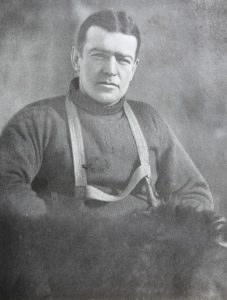
South – The Story
South is a polar classic told in Shackleton’s distinctive style. He notes in the preface: “I think that though failure in the actual accomplishment must be recorded, there are chapters in this book of high adventure, strenuous days, lonely nights, unique experiences, and, above all, records of unflinching determination, supreme loyalty, and generous self-sacrifice”. Shackleton is sure that it “will be of interested to readers who now turn gladly from the red horror of war and the train of the last five years to read, perhaps with more understanding minds, the tale of the White Warfare of the South”.
Is your copy a first edition, first impression?
The account quickly became popular, and it was published in 14 editions and 46 impressions. The first edition was published by William Heinemann and issued in four impressions. The following six points are a collector’s guide to identifying a first edition, first impression and to assess condition.

What does it look like?
The binding is in a dark blue cloth with the spine lettered in silver. The front cover is decorated with a silver vignette of the Endurance, based on the photograph “The Long, Long Night” by Frank Hurley. The back cover has the blind stamp of Heinemann. The edges of the book block are trimmed, and the top edge has a faint blue colour.
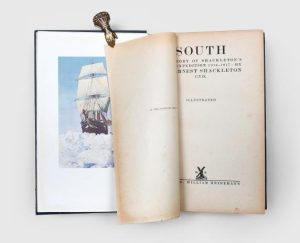
Which impression is it?
The publisher is listed as William Heinemann on the title page. Later impressions are noted as such on the verso of the title page; this page will be blank in first impressions.
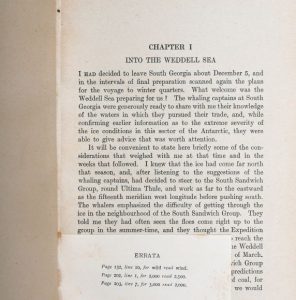
What is the paper quality like?
First impressions are printed on poor-quality paper which is prone to toning. Later impressions are printed on improved paper and will appear whiter.
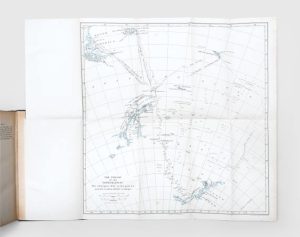 Do you have the right collation?
Do you have the right collation?
The first impression must have the collation “2 pp., xxii, 376 pp.” and an errata slip tipped onto p. 1. The second and third impressions have a similar collation though without the errata slip, as the errors have been corrected. The fourth impression is also without the errata slip, though with two additional pages in the preliminaries (pp. xxiii-xxiv) plus an addendum on the last index page. All impressions have a colour frontispiece, 87 half-tone plates, and a colour folding map at the end. The frontispiece has a tissue guard with the text “In the Pride of her Youth”, while the half-tones are identified by their well-defined dot structure. Check that your map is not a later photocopy, as maps are sometimes removed from books and sold separately.
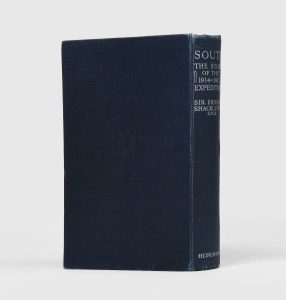
What is the condition like?
Shackleton’s book, produced while the effects of the First World War were still a reality, is rarely encountered in collectible condition. The poorly crafted binding is likely to split at the joints and the silver printing is prone to oxidizing. A fine copy is without any of these flaws.

Does it have a dust jacket?
A dust jacket for this title is a nice to have, not a need to have. They are incredibly scarce, so if one is present, it is likely tinted in light blue and the text and image of the Endurance are printed in black. We have also encountered a few examples in a cream colour with the lettering and image printed in blue.
Written by Cecilie Gasseholm, Travel Specialist

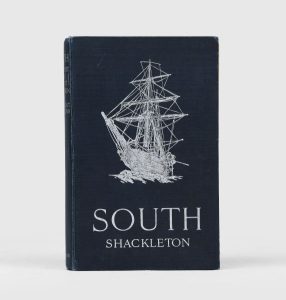 The Imperial Trans-Antarctic Expedition (1914-1917)
The Imperial Trans-Antarctic Expedition (1914-1917)


